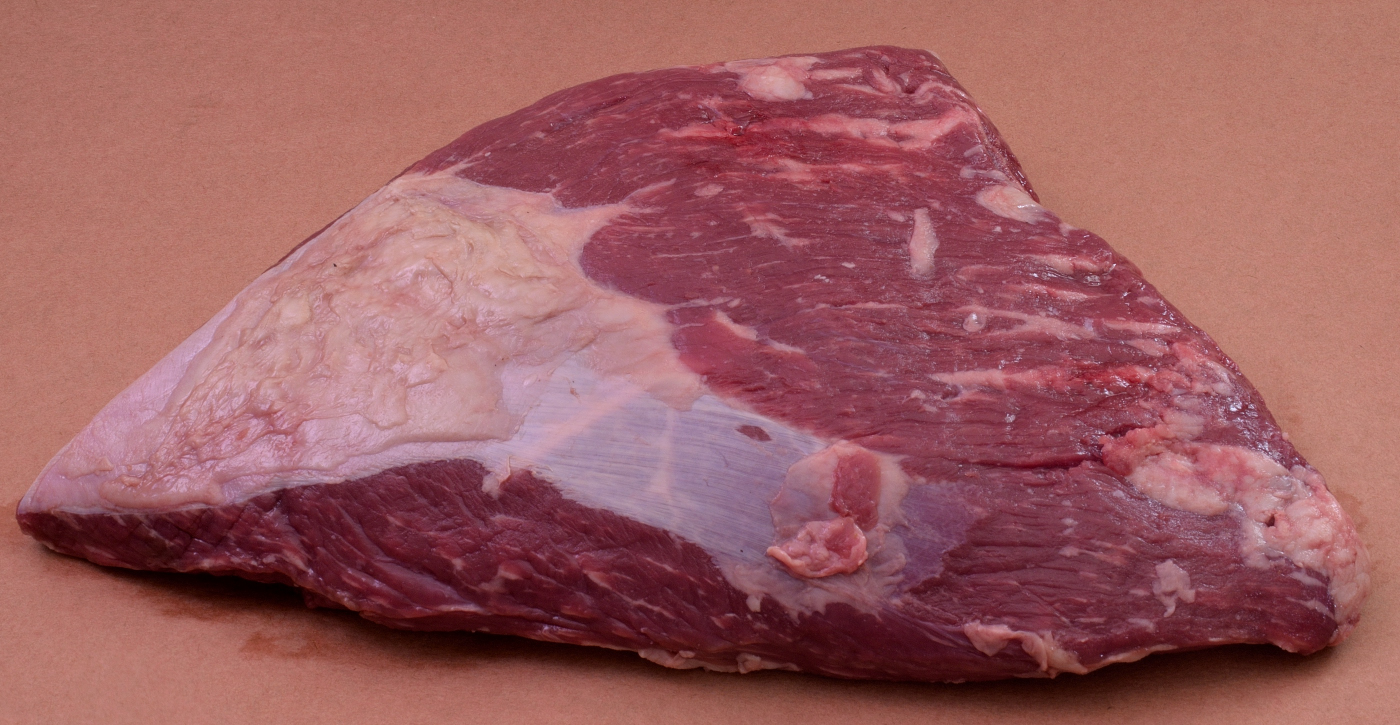
Above: Lipavi C10 container, N10 polycarbonate racks. Lipavi C10L-UNIR lid.
Actual prep time: 30 minutes
Level of difficulty: 2.75
Serves 4+
Seen below is the picanha/culotte flap, resting on top of a whole TOP SIRLOIN. Amateur butchers find the flap pretty easy to remove. The rest of us can skip ahead a couple of pics.

How do you like your steak cooked?
Here are some commonly accepted temperature setting guidelines:
Rare: 129 F/54 C.
Medium rare: 132 F/55 C.
Medium: 135 F/57 C.
Medium well: 140 F/60 C.
Well done: 150 F/66 C.

Removed from the primal, the triangular culotte/picanha has a visible cap of fat. Some aficionados highly prize the thick layer. The piece we got had only about 0.35″ so we left it intact.

Viewed from the other side, there is a small amount of silver skin to remove.

Sliced WITH the grain into steaks–when you DO see this cut in the butcher’s case, it usually looks more or less like this. These are perfectly suitable for processing just as they are, and that’s what is usually done–the same time and temperature parameters still apply.
Let freedom ring
We decided to attempt a more novel presentation. Culinary gadget departments (or on-line) usually offer a wide variety of “cookie cutters,” biscuit cutters, burger rings and so forth that are suitable. We used metal because we intended to leave the ring on for the searing process.

Bend around with the fat side out, push the steak into the ring and vacuum.

We used a couple of different sized rings. One we just did the best we could–I believe that ended up getting served to the “staff.” The worst case scenario is that the steak unrolls and looks “normal.” Actually, I anticipated that as a distinct possibility.
Processing
Set the sous vide bath to the temperature from the table above that most closely matches your preference. We used
130 F/54 C to achieve rare/medium rare.
Process at the chosen temperature for approximately six hours. A certain amount of tenderization is desirable for this particular cut, depending on preference. The longer it stays in the bath, the more tender it will become. In the unlikely event that you forget or fall asleep, you will be surprised to discover how forgiving sous vide processing is. A total loss is rare.
Once the tournedos are processed/pasteurized, shock in iced water to 70 F/21 C before refrigerating at 40 F/4 C. In the sealed state, the steaks can be safely refrigerated for at least two weeks.
Service: coming down the stretch
Carefully remove the steak(s) from the package and pat dry with a paper towel.
Collect the juices and process for future use if desired as explained HERE.
Dust lightly with powdered egg white. For people sensitive to egg products, I have found powdered buttermilk to be a suitable substitute.
Use a spray bottle to mist lightly–this will dissolve the powdered product. If you are using fresh egg whites, this step is unnecessary.
Season as desired–I used kosher salt, white pepper and dried parsley, as is my custom. We also have a wide assortment of custom seasonings/rubs located HERE.
Turn over and repeat the process.
Making it hot
The searing process can be done in a 350 F/176 C pan or in a 450 F/230 C oven or both, which was my choice. The pan does a good job caramelizing the surface while the oven does a good job melting the layer of fat around the edge. Since the steak starts out at 40 F/4 C (do NOT bring to room temperature before searing), the risk of overcooking is minimal. We target an internal temperature of 130 F/54 C or thereabouts, generally considered to be mouth hot.
Brown in a few drops of vegetable oil for up to a minute on the first side. Turn the tournedo over and stage into the oven for 6-10 minutes until the desired appearance is achieved. A probe thermometer is a good tool to have in the arsenal, but with practice they become somewhat less necessary. Remove the steak(s) from the oven and place on top of the stove. If you used your skillet to finish the steak in the oven, put a dry towel on the handle in case you forget momentarily just how long metal can stay hot.

The steak did “unfurl” a bit, we will adapt.
Presentation #1
It’s nice to offer options!
Using hot plates to assemble a simple presentation is second nature to frequent practitioners. The method for creating the shaped (purple) potato can be viewed in my primitive YouTube video linked HERE.
Assorted sauces create a vibrant visual effect, but of course are always optional. For that matter there is no shame in ketchup.
In the picture, Catalina, demi-glace, and an emulsified lemon mustard vinaigrette with some avocado puree in it. Chopped parsley.
Presentation #2
Again, very simple.

For this model, we wrapped the tournedo in blanched bacon and secured it with a couple of tooth pics.
Just the one sauce and well drained spinach blended with mascarpone cheese (or cream cheese) alongside. Bring one ounce of heavy cream to a boil and then dissolve 1.5 oz of cold butter into it, pinch of salt.
Norm King
Click on my name to visit Sous Vide Resources on Facebook!










